Complete Solutions to JEE SECTION of chapter ATOMIC STRUCTURE of Class 11 book with complete answers and questions
| Class 11 | CHEMISTRY |
| Chapter | ATOMIC STRUCTURE |
| ERRORLESS | JEE SECTION |
| Number Of Questions | 75 |
| Academic Year | 2023-24 |
The number of neutrons in dipositive zinc ion with mass number `70` is.
View SolutionThe number of electrons in one molecule of `CO_2` are
View SolutionRutherford's `alpha` particle scattering experiment eventually led to the conclusion that
View SolutionHow many upaired electrons are present in `Ni^(2+)`?
View SolutionWho discovered neutron?
View Solution`CO` has same electrons as of the ion that is isoelectronic with `CO` is.
View SolutionA p-orbital can accommodate upto :
View SolutionThe principal quantum number of an atom is related in the
View SolutionWhich electronic level would allow the hydrogen atom to absorbs a photon but not to emit a photon
View SolutionThe correct set of four quantum numbers for valence electrons of rubidium atom (Z=37) is
View SolutionThe increasing order (lowest first) for the values of `e//m` (charge//mass) for electron `(e)`, proton `(p)`, neutron `(n)`, and alpha particle `(alpha)` is
View SolutionThe radius of an atomic nucleus is of the order of
View SolutionElectromagnetic radiation with maximum wavelengths is :
View SolutionBohr's model can explain
View SolutionWhich one of the following sets of quantum numbers represents an impossible arrangement ?
View SolutionThe ratio of the energy of a photon of 2000Å wavelength radiation to that of 4000Å radiation is
View SolutionThe triad of nuclei that is isotonic is
View SolutionThe wavelngth fo a spectrl line for an electronic transition is inversely related to :
View SolutionThe outermost electronic configuration of the most electronegative element is
View SolutionThe orbital diagram in which the Aufbau's principle is violated
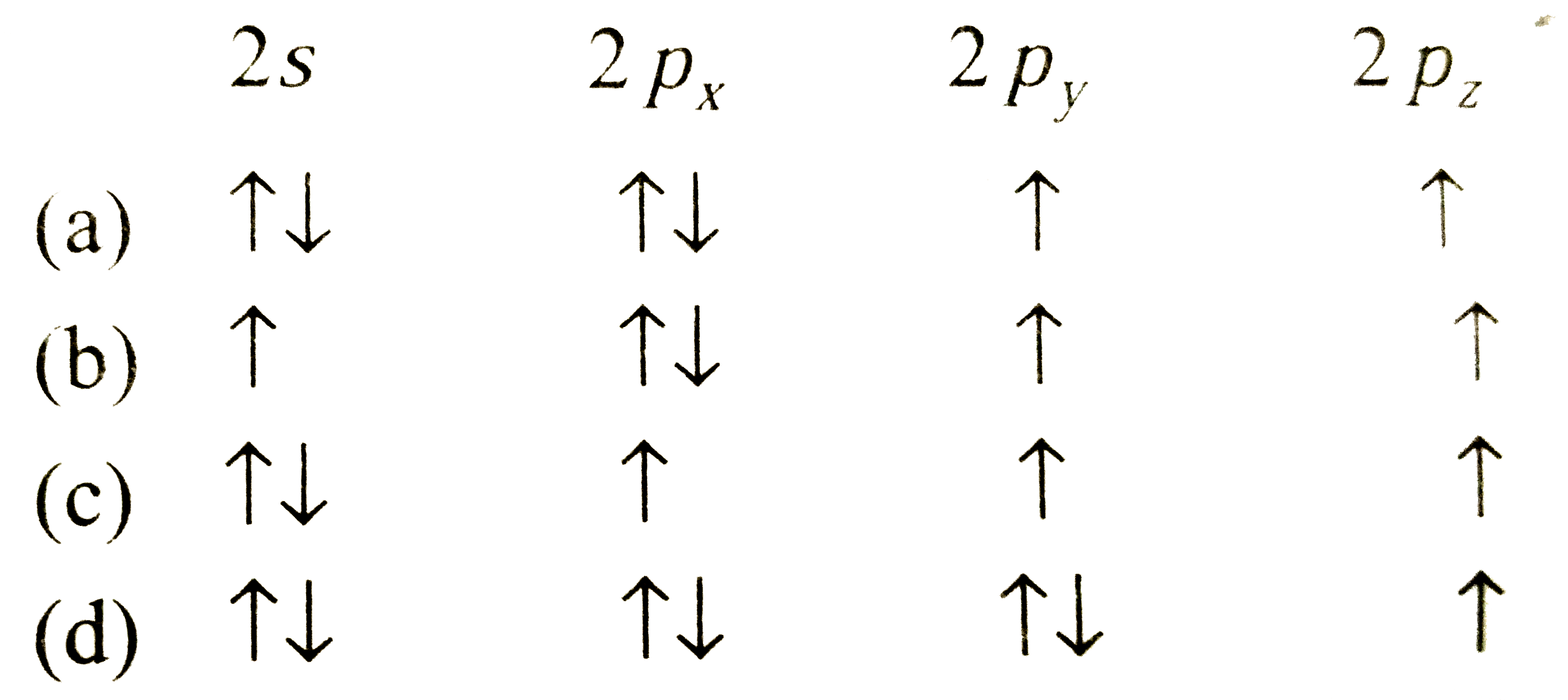
View SolutionThe correct ground state electronic configuration of chromium atom(Z=24) is :
View SolutionThe correct set of quantum numbers for the unpaired electron of chlorine atom is
View SolutionWhich of the following does not characterise X-rays?
View SolutionWhich of the following relates to photons both as wave motion and as a stream of particles?
View SolutionA 3p-orbital has :
View SolutionThe orbital angular momentum of an electron in `2s`-orbital is
View SolutionFor `d` electron, the orbital angular momentum is
View SolutionNuclei tend to have more neutrons than protons at high mass numbers because
View SolutionThe energy of an electron in the first Bohr orbit of H atom is `-13.6 eV`. The possible energy values (s) of the excited state (s) for electron in bohr orbits of hydrogen is (are)
View SolutionThe energy of the electron in the first orbit of `He^+` is `- 871.6 xx 10^-20 J`. The energy of the electron in the first orbit of hydrogen would be.
View SolutionThe electrons identified by quantum numbers n and l :-
(a) n=4, l=1 (b) n=4, l=0 (c ) n=3, l=2 (d) n=3, l=1
Can be placed in order of increasing energy as
View SolutionThe electronic configuration of an element is `1s^(2)2s^(2)2p^(6)3s^(2)3p^(6)3d^(5)4s^(1)` .This represents its
View SolutionThe number of nodal planes in a `p_x` orbital is.
View SolutionThe wavelength associated with a golf ball weighing `200 g` and moving at a speed of `5 m h^(-1)` is of the order
View SolutionThe quantum number `+ 1//2` and `-1//2` for the electron spin represent
View SolutionRutherfords experiments , which established the nuclear model of atom , used a beam of:-
View SolutionIf the nitrogen atom has electronic configuration `1s^(7)`, it would have energy lower than that of the normal ground state configuration `1s^(2)2s^(2)2p^(3)` because the electrons would be closer to the nucleus. Yet `1s^(7)` is not observed because it violates
View SolutionThe number of radial nodes fo 3s and 2p orbitals are respectively:
View SolutionThe kinetic energy of an electron in the second Bohr orbit of a hydrogen atom is [`a_0` is Bohr radius] :
View SolutionEnergy of an electron is givem by `E = - 2.178 xx 10^-18 J ((Z^2)/(n^2))`. Wavelength of light required to excited an electron in an hydrogen atom from level `n = 1` to `n = 2` will be
`(h = 6.62 xx 10^-34 Js` and `c = 3.0 xx 10^8 ms^-1`).
View SolutionWhich of the following is the energy of a possible excited state of hydrogen?
View SolutionA stream of electrons from a heated filament was passed between two charged plates kept at a potential difference V esu. If c and m are charge and mass of an electron repectively, then the value of `h//lambda` (where `lambda` is wavelength associated with electron wave) is given by :
View Solution`P` is the probability of finding the Is electron of hydrogen atom in a spherical shell of infitesimal thickness, dr, at a distance `r` from the nucleus. The volume of this shell is `4pi r^(2)dr`. The qualitative sketch of the dependence of `P` on r is
View SolutionThe radius of the second Bohr orbit for hydrogen atom is :
(Planck's constant, `h = 6.6262 xx 10^(-34) Js`, mass of electron = `9.1091 xx 10^(-31) kg`, charge of electron `e = 1.60210 xx 10^(-19) C`, permittivity of vaccum `in_0 = 8.854185 xx 10^(-12) kg^(-1) m^(-3) A^2)`
View SolutionAn isotone of `._32^76Ge` is
View SolutionMany elements have non-integral atomic masses because
View SolutionPick out the isoelectronic structures from the following .
`I CH_3^+ (II) H_3O^+ , (III) NH_3, (IV) CH_3^-` :
View SolutionWhich of the following statement(s) is (are) correct
View SolutionGround state electronic configuration of nitrogen atom can be represented by:

View SolutionWhich of the following have the same number of unpaired electrons in 'd' orbitals
View SolutionThe radial distribution functions `[P(r)]` is used to determine the most probable radius, which is used to find the electron in a given orbital `(dP(r))/(dr)` for `1s`-orbital of hydrogen like atom having atomic number `Z`, is `(dP)/(dr)=(4Z^(3))/(a_(0)^(3))(2r-(2Zr^(2))/(a_(0)))e^(-2Zr//a_(0))` :
View SolutionSelect the correct cruve (s)
If V=velocity of electron in Bhor's orbit ltbr. R= Radius of electron im Bhor 's orbit
P.E= Potential energy of electron in Bhor 's orbit
K.E.=kinetic energy of electron in Bhor 's orbit.
View SolutionStatement: Nuclide `._(13)^(30)Al` is less stable than `._(20)^(40) Ca`
Explanation: Nuclides having odd number of protons and neutrons are general unstable.
View SolutionBand gap in germanium is small.
The energy spread of each germanium atomic energy level is infinitesimally small.
View SolutionStatement : The plot of atomic number ( y -axis ) versus number of neutrons ( x -axis ) for stable nuclei shows a curvature towards x-axis fron the line of ` 45^@` slope as the atomic number is increased .
Explanation : proton -proton electrostatic repulsions begin to overcome attracive forces involving protons and neutrons in heavier nuclides.
View Solution`e//m` ratio in case of anode ray experiment is different for different gases.
The ion of gases formed after the ejection of electron are different of gas is different.
View SolutionStatnment -I : Radial part of wave function for 2s & 2p is not same
Statement -II : Radial part of wave function depends upon is zero at nucleus for all p & d orbitals.
upon "l" and "m" only.
View SolutionThe hydrogen -like species ` Li^(2+)` is in a spherically symmetric state ` S_1` whth one radisal node . Upon absorbing light the ion undergoes transitoj ot a state ` S_2` has one radial node and its enrgy is equal to the groun sate energy of hhe hydrogen atom.
The orbital angular momentum quantum number of the state ` s_2` is :
View SolutionThe hydrogen -like species `Li^(2+)` is in a spherically symmetric state `S_(1)` with one node. Upon absorbing light , the ion undergoes transition to a state `S_(2)`. The state `S_(2)` has one radial node and its energy is equal is to the ground state energy of the hydrogen atom.
Energy of the state `S_(1)` in units of the hydrogen atom ground state energy is
View SolutionThe hydrogen -like species `Li^(2+)` is in a spherically symmetric state `S_(1)` with one node. Upon absorbing light , the ion undergoes transition to a state `S_(2)`. The state `S_(2)` has one radial node and its energy is equal is to the ground state energy of the hydrogen atom.
The sate `S_(1)` is
View SolutionQuantum number area assigned to get complete inforamtion of electrons regarding their energy engular momentum ,spectral lines etc. Four quantum number are known i.e pricipal quantum numbers which tell the diatence shell and its angular momentum .Azimuthal and of courase shape of orbital , Magnetic qunatum number deals with syudy of orientations or deganeracy of a subshell . spin quantum number defines te spin of electrons designaated as `+(1)/(2) or-(1)/(2)` respresented by 123 and 123 respectively .
Electrons are filled in oritals and Hun's rule of maximum multicity .
spin angular momentum for unpaires electron in sodium (Atomic No =11 ) is :
View SolutionQuantum number area assigned to get complete inforamtion of electrons regarding their energy engular momentum ,spectral lines etc. Four quantum number are known i.e pricipal quantum numbers which tell the diatence shell and its angular momentum .Azimuthal and of courase shape of orbital , Magnetic qunatum number deals with syudy of orientations or deganeracy of a subshell . spin quantum number defines te spin of electrons designaated as `+(1)/(2) or-(1)/(2)` respresented by 123 and 123 respectively .
Electrons are filled in oritals and Hun's rule of maximum multicity .
Number of electrons having the quantum numbers n=4, l=0, `s=-(1)/(2) in Zn^(+2)` ion is /are :
View SolutionQuantum number area assigned to get complete information of electrons regarding their energy angular momentum ,spectral lines etc. Four quantum number are known i.e principal quantum numbers which tell the distinct shell and its angular momentum .Azimuthal tell about subshell and Magnetic quantum number deals with different orbitals in subshell. spin quantum number defines the spin of electrons designated as `+(1)/(2) or-(1)/(2)`
Electrons are filled in orbitals according to Hund's rule of maximum multiplicity .
Two unpaired electrons present in carbon atom are different with respect to their :
View SolutionThe maximum number of electrons that can have principal quantum number, n = 3, and spin quantum number `m_(s)` = - 1 /2, is
View SolutionThe work function `(phi)` of some metals is listed below . The number of metals which will show photoelectric effect when light of 300 nm wavelength falls on the metal is :

View SolutionThe atomic masses of He and Ne are 4 and 20 amu respectively . The value of the de Broglie wavelength of He gas at`-73.^(@)C` is ''M'' times that of the de Broglie wavelength of Ne at `727.^(@)C.` M is
View SolutionIn an atom, the total number of electrons having quantum numbers
`n = 4,|m_(l)| = 1` and `m_(s) =- (1)/(2)` is
View SolutionNot considering the electronic spin, the degeneracy of the second excited state (n=3) of H atom is 9, while the degeneracy of the second excited state of H– is
View SolutionIn the Bohr model of the hydrogen atom, the ratio of the kinetic energy to the total energy of the electron in a quantum state `n` is ……..
View SolutionElectron falls from `7^"th"` energy level and lower energy levels to produce bands in the Paschen series. The total number of bands obtained will be
View SolutionThe highest excited state that an unexcited hydrogen atom can reach when they are bombarded with ` 12.2 eV` electron is :
View SolutionThe wave function , `Psi_(n,l,m)` is a mathematical function whose value depends upon spherical polar coordinates `(r , theta, phi)` of the electron and characterized by the quantum number n, l and `m_1` . Here r is distance from nucleus , `theta` is colatitude and `phi` is azimuth . In the mathmatical functions given in the table , Z is atomic number and `a_0` is Bohr radius.
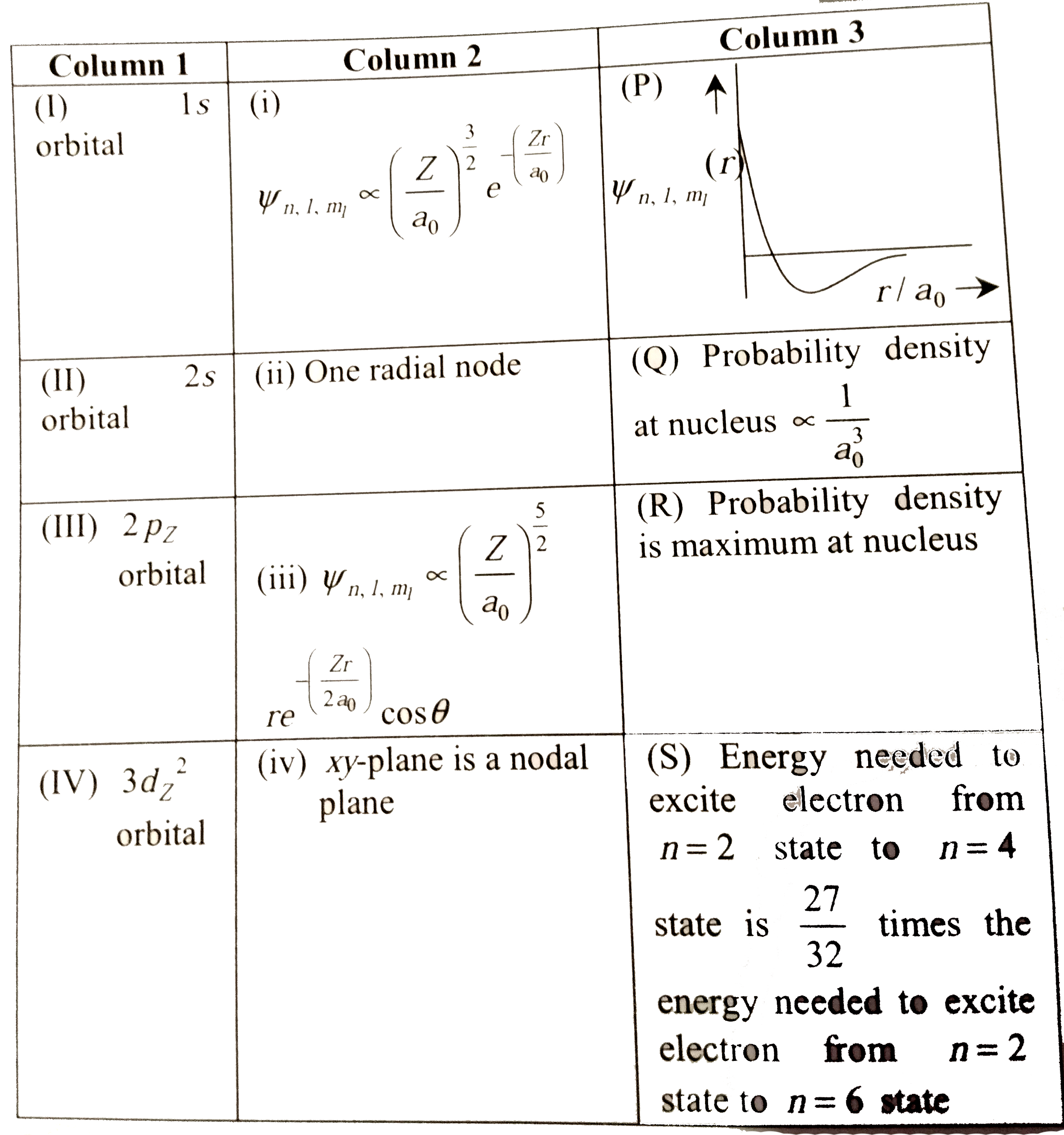
For `He^+` ion , the only INCORRECT combination is
View SolutionThe wave function , `Psi_(n,l,m)` is a mathematical function whose value depends upon spherical polar coordinates `(r , theta, phi)` of the electron and characterized by the quantum number n, l and `m_1` . Here r is distance from nucleus , `theta` is colatitude and `phi` is azimuth . In the mathmatical functions given in the table , Z is atomic number and `a_0` is Bohr radius.
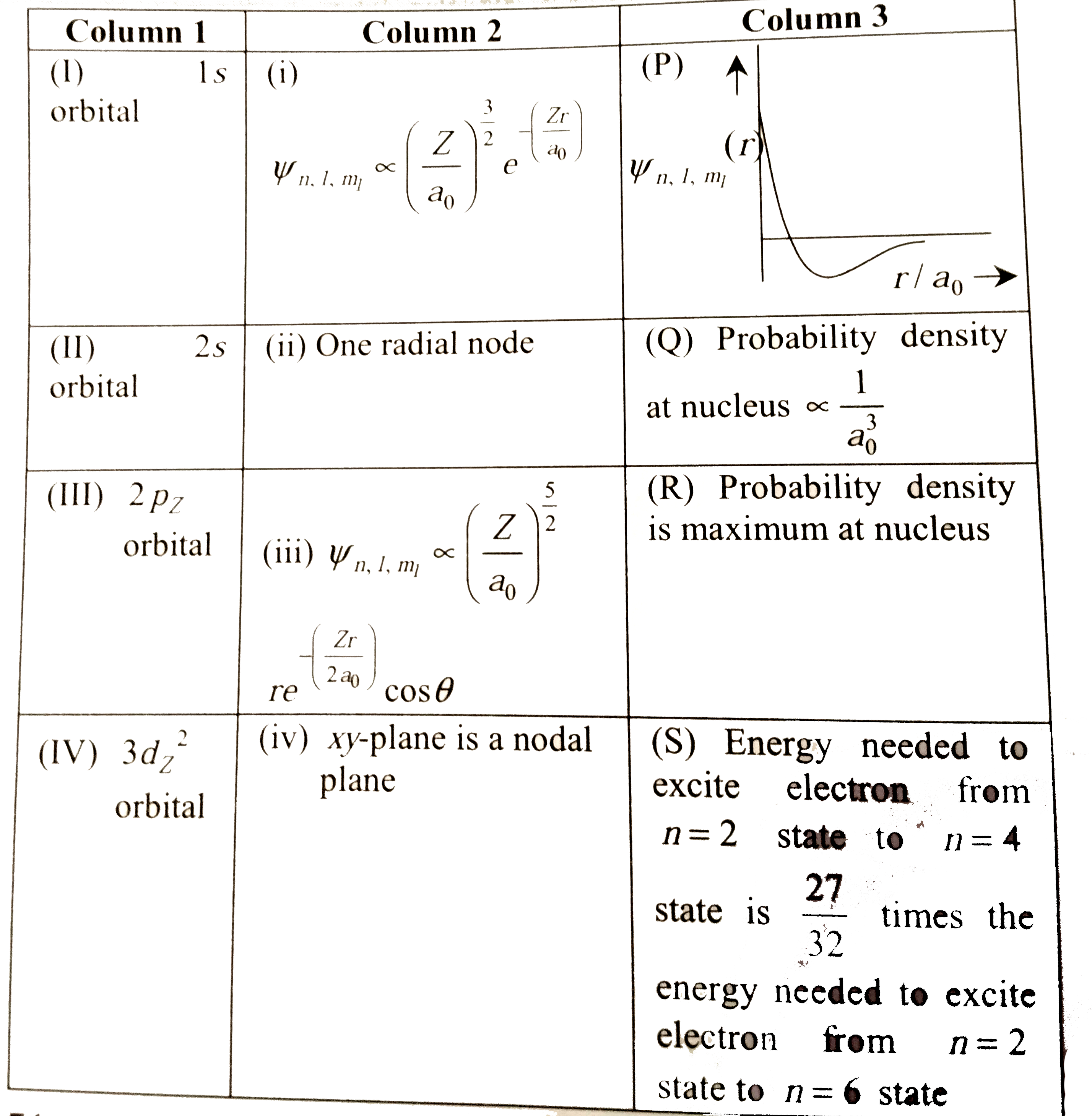
For the given orbital in Column I , the only CORRECT combination for any hydrogen-like species is
View SolutionThe wave function , `Psi_(n,l,m)` is a mathematical function whose value depends upon spherical polar coordinates `(r , theta, phi)` of the electron and characterized by the quantum number n, l and `m_1` . Here r is distance from nucleus , `theta` is colatitude and `phi` is azimuth . In the mathmatical functions given in the table , Z is atomic number and `a_0` is Bohr radius.
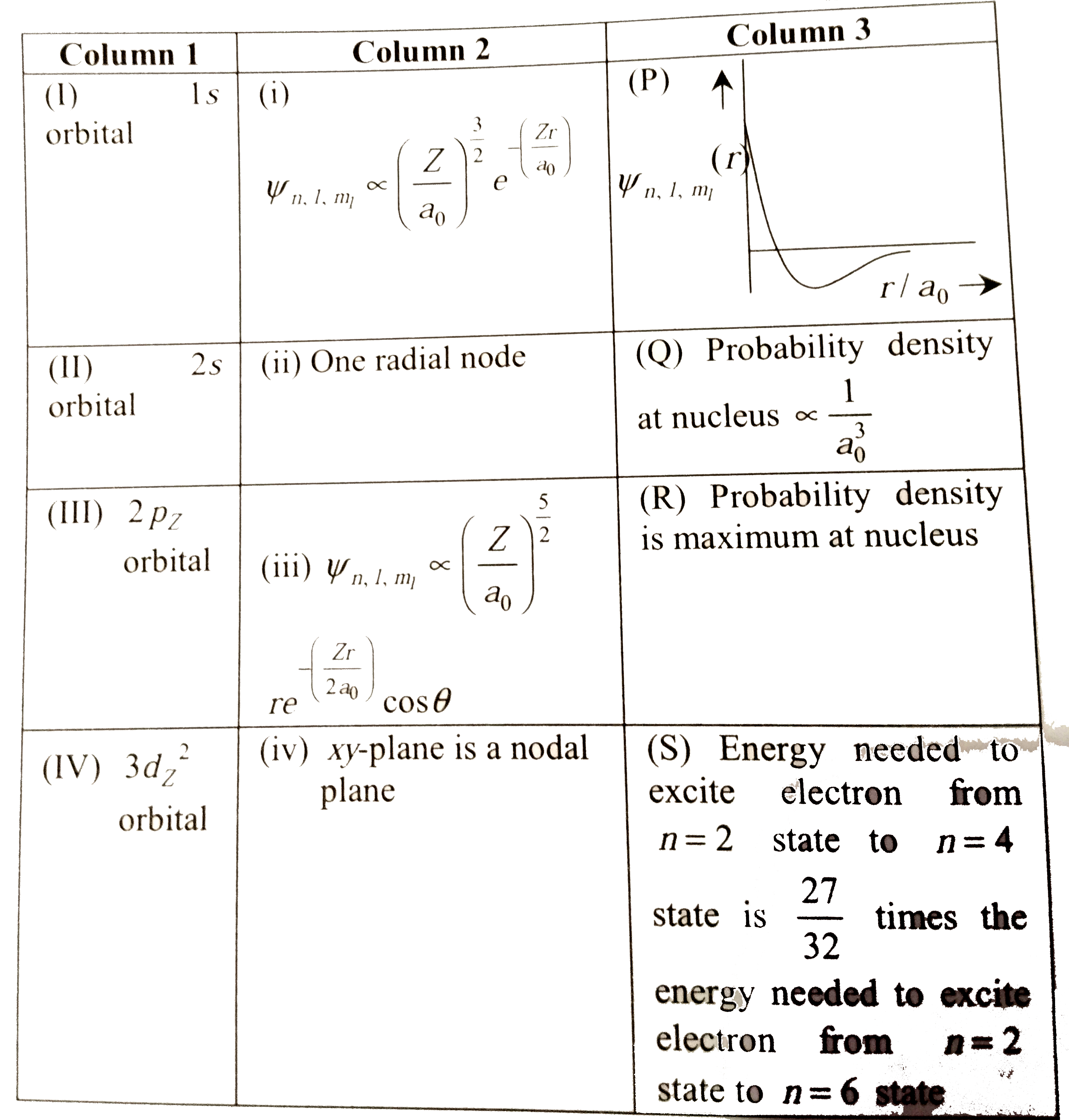
For hydrogen atom, the only CORRECT combination is
View SolutionMatch the entries listed in Column I with appropriate entries listed in Column II
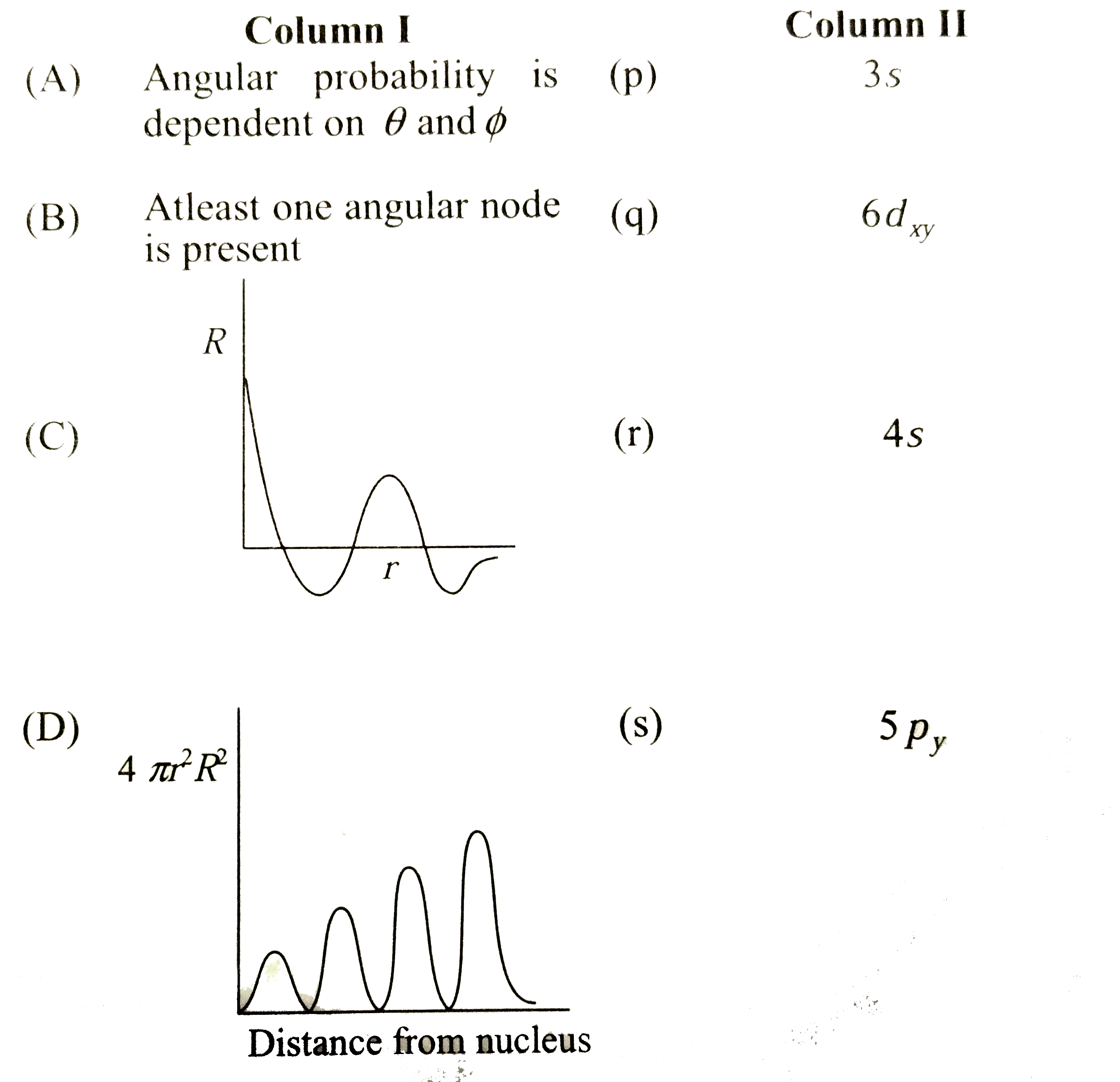
View Solution
JEE SECTION questions and complete solutions for chapter ATOMIC STRUCTURE of UNIVERSAL BOOK DEPOT 1960 CHEMISTRY (HINGLISH) of Class 11
All Exercises from ERRORLESS Class 11 CHEMISTRY ATOMIC STRUCTURE
- Atomic models and Plancks quantum theory
- Atomic number, Mass number, Atomic species
- CRITICAL THINKING
- Dual nature of electron
- JEE SECTION
- JEE SECTION (Matrix Match Type Questions)
- ORDINARY THINKING
- Quantum numbers , Electronic configuration and Shape of orbitals
- Uncertainty principle and Schrodinger wave equation